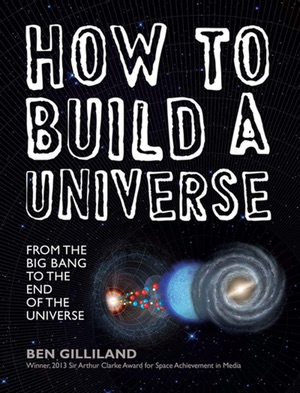Review: How to Build a Universeby Jeff Foust
|
| “…sadly, diprotons are the subatomic equivalent of Richard Burton and Elizabeth Taylor—their union is very unstable and they quickly separate.” |
One of the latest to try an innovative approach to discussing these topics is Ben Gilliland. A former science columnist and graphics editor for the UK newspaper Metro, he applies both writing and illustrating skills to How to Build a Universe. The result is a surprisingly enjoyable book that traces the history of the universe from the Big Bang to the formation of our solar system.
How to Build a Universe covers a familiar array of topics: the Big Bang, cosmic inflation, quantum mechanics and the fundamental particles of matter, dark matter and dark energy, and so on. There’s nothing written here that hasn’t been discussed, in one form or another, in hundreds of other books. The challenge that this book—or any other on the topic—faces is to set itself apart from all those others.
Gilliland accomplishes this through a combination of a lively writing style and distinctive illustrations. For example, he illustrates the menagerie of subatomic particles using LEGO-like building blocks. And his writing helps clearly explain concepts while not taking them—or himself—too seriously. For example, in discussing the creation of a proton pair called the diproton: “…sadly, diprotons are the subatomic equivalent of Richard Burton and Elizabeth Taylor—their union is very unstable and they quickly separate.”
At times, that wry style can become a bit too much, and the conversion of units can be a little clunky at times (in a discussion of entropy, Gilliland refers to a coffee cup at 158°F in a room at 68°F, which seems oddly specific until you realize that’s 70°C and 20°C, respectively.) If you’re already familiar, at least at a basic level, with physics and cosmology, How to Build a Universe won’t offer you much new information. For newcomers, and for those who have tried but failed to understand these topics in the past, this book may offer a more accessible, and enjoyable, introduction to them.
